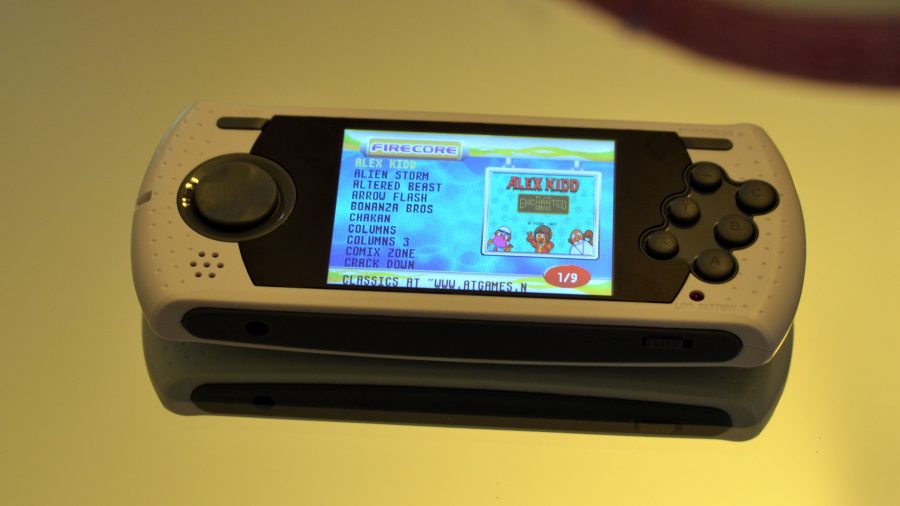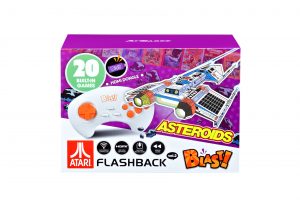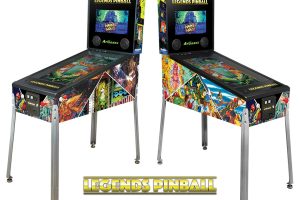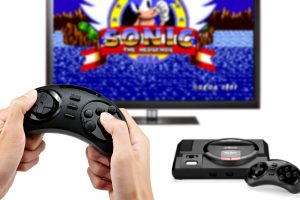AtGames has released the 2016 version of their Sega Genesis Ultimate Portable Game Player, which is just now starting to be available from major US retailers. While list price is $69.99, typical retail price is often quite a bit less.
The Ultimate Portable Game Player is part of the new AtGames Flashback Zone, which encompasses an increasing number of retro-themed products and a new social media presence on both Twitter and Facebook. The AtGames Flashback Zone is expected to be the AtGames retro gaming portal going forward and should hopefully see regular expansion. Other products for this year include: Atari Flashback 7 (available now), Atari Flashback Portable (available November), Sega Genesis Classic Game Console (available now), and Atari Flashback Classics Volume 1 and Volume 2 for Sony’s PlayStation 4 and Microsoft’s Xbox One (both available soon). I should eventually have reviews posted for all of those products, although you can check out the reviews for the Atari Flashback 7 and Sega Genesis Classic Game Console now.
This year’s edition of the Ultimate Portable Game Player sports the 25th Anniversary Sonic the Hedgehog logo on the box and an addition of one extra Sonic-centric game, Sonic 3D Blast. Of course, that’s not the only change for this year’s edition, which I detail in the next section.
Note that this review will be substantially similar to the one for the Sega Genesis Classic Game Console, because they use the same hardware foundation. The main difference between the two is that one is an up to two player console that accepts cartridges, while the other is a single player handheld that accepts an SD card.
Differences from the 2015 Version
You can see the game list for this version here, and the 2015 version here. There are 39 original Genesis games, and 41 newer games that are coded to be Genesis-like, but take advantage of the extra capabilities of the AtGames hardware.
While there are a few fun titles in the list of those 41 newer games, their quality is highly variable and naming conventions are all over the place, so it’s difficult to judge what’s been added or dropped. To be clear, there are some differences between what’s in the 2015 version versus what’s in this 2016 version, but I’m not going to parse them on the lists. That’s because most important is what original Sega games have been dropped and which have been added.
Lost from the 2015 version are: Ecco, Ecco Jr, Streets of Rage, Streets of Rage 2, Streets of Rage 3, and Virtua Fighter 2. New additions for 2016 are: Eternal Champions, Phantasy Star II, Phantasy Star III, Sonic 3D Blast, and Sword of Vermilion. It’s with the additions of the Phantasy Star II, Phantasy Star III, and Sword of Vermilion role-playing games that the biggest change reveals itself: save game support. Otherwise, the hardware itself is virtually identical.
Handheld Hardware
In the box is the handheld, miniUSB cable, and instructions. The handheld measures approximately 5.5 inches across, 2.5 inches high, and about three quarters of an inch deep.
On the top of the unit is an LED that lights red during charging and lights yellow once fully charged. To the right of the LED is an AV out port to play on a TV (cable not included, but usually available from the AtGames Flashback Zone), miniUSB charging port, SD card slot (full-sized), and a volume dial.
On the rear of the unit is the rechargeable battery cover. You’ll get between 3 – 5 hours of usage from a full charge.
On the left front of the unit, starting at the top, is a MENU button, which returns you to the main menu at any time, a d-pad, and a single speaker. In the middle front of the unit is the 3.2″ screen. On the right front are buttons that mimic the functionality of a Sega Six Button Control Pad, and includes a START/PAUSE button, and A, B, C, X, Y, and Z buttons. Below those buttons is a low battery indicator, which becomes lit when the battery needs charging.
Finally, on the bottom of the unit is a 3.5mm headphone (or speaker) jack and an ON/OFF switch.
Games
The menu system is straightforward. Move up and down or left and right to move between the games and pages of games, respectively. Once you select a game by pressing START/PAUSE, it starts up the same as it does on a standard Sega Genesis.
Of the 80 included games, as mentioned, 39 are originals from back in the platform’s prime, while the other 41 are later, more generic Genesis-like releases that are a mix of casual games and typically lower quality clones of popular titles. However you choose to look at the selection, it’s still a good value, particularly since you can easily augment what’s included with ROMs on an optional SD card.
You can get a good idea for how the built-in games look and sound by watching the videos under Games from my Sega Genesis Classic Console review.
Here’s a sampling of a few more of the built-in games to give you an idea of how they look and sound:
Golden Axe III
Vectorman 2
Jack’s Pea
The RPG Games
Saving and loading works the same for Phantasy Star II, Phantasy Star III, and Sword of Vermilion as it does if you were using the original cartridges on an original console. Here’s a sample of one of those games:
Sword of Vermilion
SD Card Usage
The Ultimate Portable Game Player accepts SD cards up to 8GB in size. Simply format the card, make a directory named “GAME” or “Game” and place the .bin files of your choice. SD CARD is the last option on the main menu.
Here’s some samples running from the SD card:
Mick & Mack as the Global Gladiators
The Incredible Hulk
Audio/Video
You can judge for yourself from the included videos, but, for the most part, there are some minor color and sound variations versus what you’d get from a real Sega Genesis console. Worst is probably the sound simulation, as some notes sound almost “sour.” With that said, everything is still perfectly playable, and, unless you’re looking for specific differences, you likely won’t be too bothered by any of the drop-off in relative audio-video quality. It’s also less noticeable when played strictly from the portable screen.
The built-in LCD has good brightness and no motion blur. It does a good job of displaying the low resolution content. There’s a single speaker, but you can plug in stereo headphones for added audio punch.
There is also an AV connection, which allows you to connect to an external display with an optional AV cable (again, usually available from the AtGames Flashback Zone). When you plug in the cable, the internal screen goes off and the picture and sound are displayed on the TV. As you would expect, the composite connection is just about the poorest connection available, but also the most universally compatible, especially with the type of older CRT TVs the Sega Genesis games were originally intended for. It’s best to use the AV output of this portable with one of those older TVs as video quality will vary dramatically on modern displays, although is still usable. You’ll want to make sure the games display in their original 4:3 format (like in the portable’s own native aspect ratio) rather than 16:9 (widescreen), although that’s more of a pet peeve of mine than a strict requirement.
Conclusion
Although far from perfect, even if you discount the 41 “other” games from the 80 total, the price of entry works out to less than $1 per original title at retail. Add in the save support for the three included RPG games, as well as an SD card slot to add whatever other games you want at roughly Sega Genesis 3 or Sega Nomad levels of compatibility, but in a more compact form factor, and you come out with an extremely compelling product.
Pluses:
- Nice screen
- Headphone jack
- Composite AV output to play on a TV
- Value-packed game selection
- Save game support for the three included RPGs
- SD card support to add your own games
Minuses:
- Poor audio quality
- The Composite AV output cables are not included
Thanks to AtGames for providing the review unit.
DISCLOSURE STATEMENT: I advise AtGames as an Independent Contractor. Opinions expressed in this review are solely my own, with no external approval.












 Your total news and information resource for all things Science, Technology, Engineering / Mathematics, Art, and Medicine / Health.
Your total news and information resource for all things Science, Technology, Engineering / Mathematics, Art, and Medicine / Health.
25 Comments
Leave your reply.